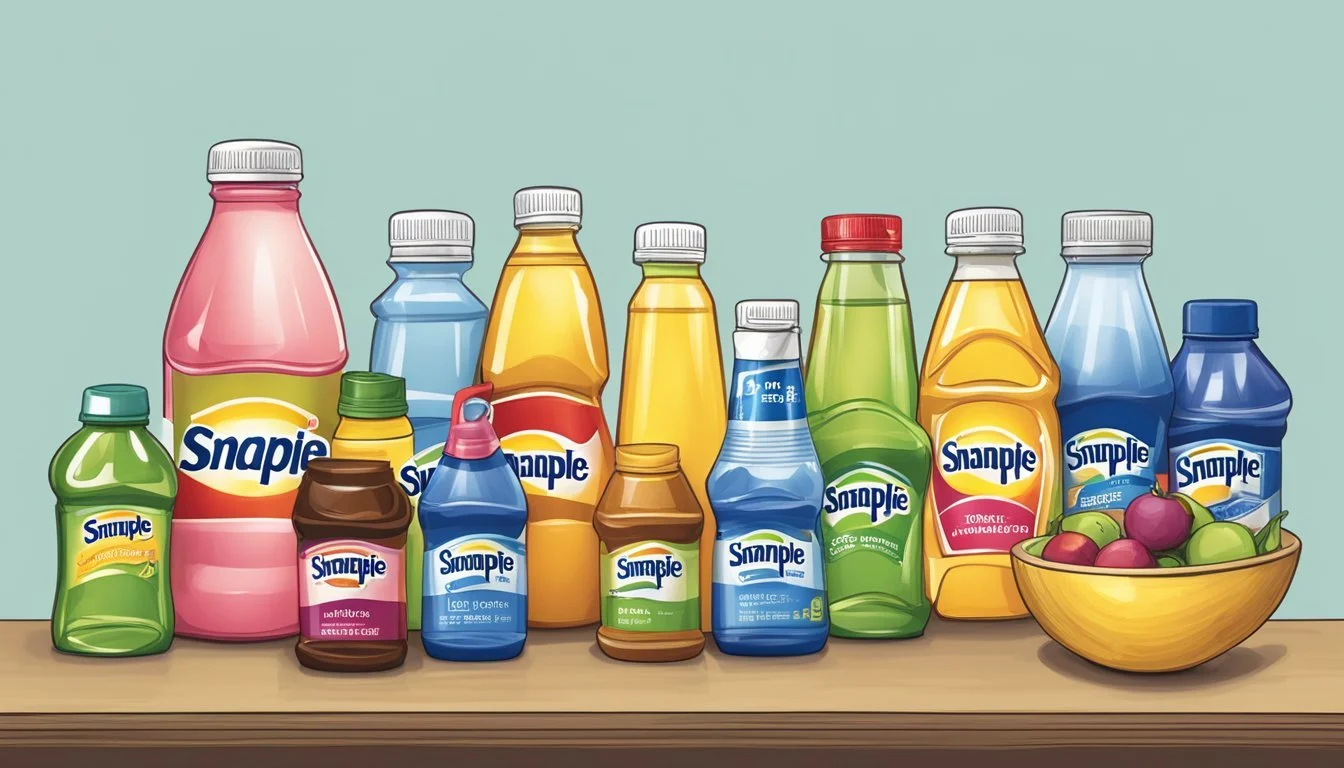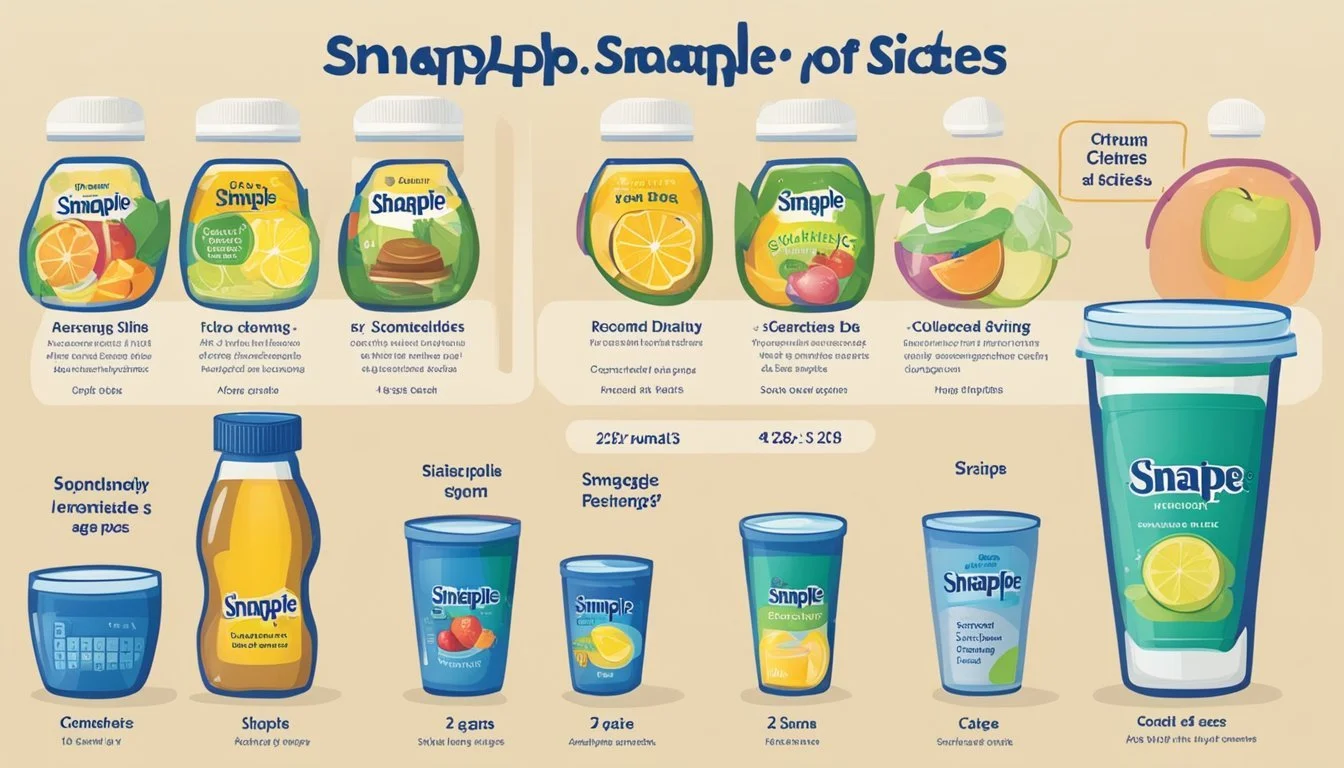How Many Servings of Snapple Drink Is Too Much
Expert Guidelines
People enjoy a refreshing Snapple drink, whether it's one of their classic teas, juice drinks, or the newer Snapple Elements with reduced sugar. Snapple's beverages are known for their delightful flavors, but how many servings can a person have before it becomes too much? Health experts recommend moderation, suggesting that more than one or two servings of sugary drinks per day could lead to health issues.
Snapple provides detailed nutritional information for their products. For instance, a 16 fl oz Snapple Apple Drink contains 200 calories mainly derived from sugars. Consuming multiple servings of such drinks can contribute to excessive caloric intake and higher sugar consumption, potentially leading to weight gain and other metabolic problems.
It's important to consider the lighter options, like Snapple Elements, which contain 45% less sugar compared to regular Snapple drinks. Opting for such variations could help manage sugar intake better while still enjoying the flavors Snapple has to offer.
Understanding Snapple Drink
Snapple offers a variety of beverages with diverse flavors and ingredients. It’s important to explore what goes into each drink and how its nutritional content might affect your daily intake.
Ingredients and Varieties
Snapple drinks come in multiple flavors, including strawberry pineapple lemonade, watermelon lemonade, and black cherry lemonade. Ingredients typically include filtered water, sugar, fruit juice concentrates, citric acid, natural flavors, and vegetable and fruit juices for color.
Diet Snapple uses aspartame instead of sugar, making it a low-calorie option. Some flavors also contain caffeine, while others are caffeine-free. For example, the Snapple Apple Juice Drink includes both apple and pear juice concentrates, along with 10% juice content.
Nutrition Facts and Health Considerations
The nutrition profile of Snapple drinks varies significantly. Regular Snapple drinks usually contain around 150 calories per 16 fl oz serving and have high sugar content, often around 7 tsp of added sugars. Diet Snapple versions tend to have 0 calories or only 10 calories per serving due to the use of artificial sweeteners like aspartame.
Each Snapple flavor may also include different levels of caffeine, and most products are gluten-free. The sugar content can impact blood sugar levels and calorie intake, making it crucial to monitor how much you consume to avoid exceeding daily dietary recommendations.
Recommended Servings and Consumption Guidelines
Understanding the right amount of Snapple drink or any other sugar-sweetened beverage is critical for maintaining a healthy diet and avoiding potential health risks.
Standard Drink Definitions
When considering fruit drinks like Snapple, serving size is vital. The FDA typically defines a single serving for most beverages as 8 fluid ounces. For Snapple, this can equate to about 100 calories and varying amounts of sugar depending on the flavor. Comparing this to the general Dietary Guidelines for Americans, which recommend limiting sugar-sweetened beverages due to their high caloric content and potential negative impact on health, is essential.
Tracking servings helps avoid excess sugar. One to two servings per day of sugar-sweetened beverages can already contribute significantly to the daily recommended sugar intake.
Moderate versus Heavy Drinking
The concept of moderate drinking applied to beverages like Snapple involves consuming them in limited amounts to minimize health risks. Moderate consumption can be recommended as up to one serving per day for women and up to two servings per day for men, in line with general guidelines for sugar intake.
On the other hand, heavy or binge drinking of sugary beverages involves consuming more than the recommended amounts regularly. Consuming large quantities of sugar-sweetened drinks like Snapple can lead to an increased risk of weight gain, type 2 diabetes, and dental issues. It's important to balance these drinks with water or other healthier beverage choices.
Health Implications of Overconsumption
Consuming Snapple drinks in excessive amounts can lead to various health concerns, ranging from short-term disturbances to long-term diseases. It's important to understand the potential risks associated with drinking too many servings.
Short-term Risks
Short-term overconsumption of Snapple drinks can cause several immediate health issues. The high sugar content may lead to spikes in blood glucose levels, resulting in jitteriness or fatigue.
Weight gain can also be a concern, as the excess calories can quickly add up, contributing to obesity. Digestive problems such as bloating and discomfort might occur due to the sweeteners and artificial ingredients. In some cases, excessive intake can lead to temporary dehydration as sugary drinks fail to hydrate effectively.
Memory blackouts or other cognitive disruptions are less common but possible if large quantities contain caffeine.
Long-term Risks
Long-term consumption of large quantities of Snapple drinks poses significant health risks. One major concern is the development of type 2 diabetes, driven by the sustained high sugar intake.
Heart disease and liver disease may also be linked to chronic overconsumption due to the metabolic strain placed on these organs. Excessive caloric intake can further lead to obesity, amplifying risks for various health conditions.
Tooth decay is another serious issue, as the consistent exposure to sugar can weaken dental enamel, leading to cavities and gum disease.
Specific Health Conditions Linked to Overconsumption
One notable health issue connected to overconsumption is non-alcoholic fatty liver disease (NAFLD). High levels of fructose and sugar can lead to fat accumulation in the liver, causing inflammation and scarring.
Cardiovascular problems such as high blood pressure and elevated cholesterol levels can also develop, increasing the risk of heart attacks and strokes.
Additionally, excessive intake may interfere with medications, reducing their efficacy due to the high sugar and caffeine content. The craving for sugary drinks can also contribute to addictive behavior, similar to patterns seen in alcohol use disorder (AUD).
By understanding these risks, individuals can make more informed decisions about their Snapple drink consumption and prioritize their long-term health.
Identifying and Addressing Overconsumption
Understanding how to identify and address overconsumption of beverages like Snapple is crucial for maintaining health. This section provides clear indicators of excessive consumption and practical steps for intervention and professional advice.
Recognizing the Signs of Drinking Too Much
Consuming too much Snapple, even though it is non-alcoholic, can still lead to health issues due to additives and sweeteners. Look out for signs like excessive thirst, frequent urination, and unexplained weight gain. Overconsumption may also manifest as increased blood sugar levels, which can be a concern for those with diabetes or prediabetes.
Pay attention to habits. If someone replaces water with multiple servings of Snapple, that's a red flag. Keep watch for persistent cravings and difficulty managing intake.
Being aware of these symptoms can help in early identification and timely intervention.
Intervention and Healthcare Professional Advice
If signs of overconsumption are evident, it’s important to seek advice from healthcare professionals. Doctors and nutritionists can assess the situation and recommend appropriate interventions. They may suggest daily intake limits, alternative beverages, or adjustments to diet and exercise.
Healthcare professionals can also help identify any underlying conditions that excessive beverage consumption might indicate or exacerbate. Regular check-ups can monitor key health indicators like blood sugar levels and weight.
Prompt consultation can assist in crafting a sustainable plan for reducing unnecessary intake and improving overall health.
Resources for Assistance
Various resources are available for assistance if overconsumption of Snapple or other beverages becomes a concern. Websites and hotlines offer immediate support and information on managing unhealthy drinking habits. Consider reaching out to organizations specializing in nutrition and dietary health for comprehensive guidance.
Support groups, both online and in-person, can offer community and encouragement. Healthcare facilities also frequently have educational materials and support programs. Knowing where to seek help and accessing these resources can significantly ease the process of addressing overconsumption.
Taking advantage of these resources ensures consumers have the information and support they need to maintain healthy drinking habits.
Labels and Consumer Information
Knowing the information on Snapple drink labels helps consumers make informed choices. Understanding nutrition labels and accurately gauging serving sizes are key to managing consumption.
Understanding Nutrition Labels
Snapple drink labels present essential nutrition facts. They include details such as calories, carbohydrates, sugars, and other nutrients per serving.
For instance, a typical Snapple Apple Juice Drink contains 200 calories per 16 fl oz. It is critical to look at not just calories but also added sugars.
Snapple's Zero Sugar variants have been reformulated with no sugar and fewer calories. For those monitoring their sugar intake, this is beneficial. Other aspects like sodium and potential allergens are listed, which are crucial for individuals with dietary restrictions.
How to Gauge Serving Sizes
The serving size specified on Snapple labels is crucial in managing intake. A Snapple Apple Drink defines a single serving as 16 fl oz with 200 calories. One must note if they consume more than this, they are ingesting more than one serving.
Net carbs and sugars per serving are significant, especially for those tracking dietary goals. For example, consuming more than one bottle can quickly add up the sugars, impacting dietary plans. Calculating based on labeled serving sizes helps keep intake within limits.
Using the provided information on servings can prevent overconsumption and align with health targets.
Considerations for Special Populations
Certain groups need to approach Snapple and other beverages mindfully, especially when concerns include pregnancy and potential interactions with medications. Specific considerations can help ensure safety.
Pregnancy and Alcohol
During pregnancy, it's crucial to avoid beverages containing alcohol. Ethanol can cross the placenta, posing risks like fetal alcohol spectrum disorders (FASD). Snapple's alcoholic varieties should be specifically avoided. Non-alcoholic versions are generally safe, but always check labels for hidden ingredients. Pregnant individuals should also avoid components like excessive caffeine or artificial sweeteners, which can impact both maternal and fetal health.
Alcohol and Medication Interactions
Alcohol can interact with various medications, leading to reduced efficacy or dangerous side effects. Ethanol in beverages may alter how medications work. For instance, mixing alcohol with antidepressants can increase sedation or worsen depression. Blood pressure medication combined with alcohol might lead to severe hypotension. Always consult with healthcare providers about safe beverage choices when on medication. Monitoring alcohol intake is pivotal to mitigating these risks.





